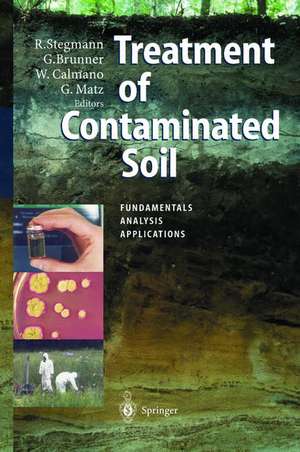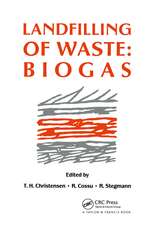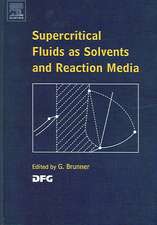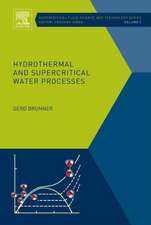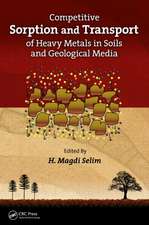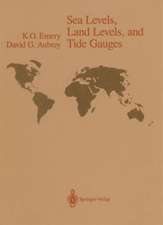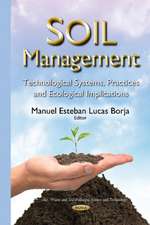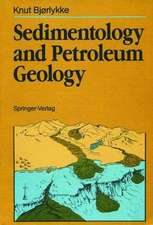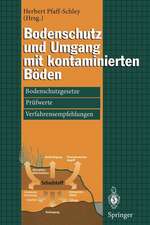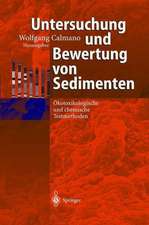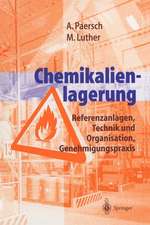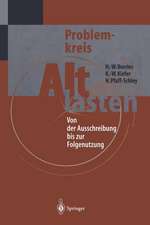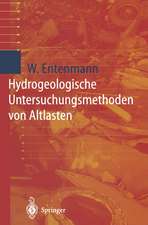Treatment of Contaminated Soil: Fundamentals, Analysis, Applications
Editat de Rainer Stegmann, Gerd Brunner, Wolfgang Calmano, Gerhard Matzen Limba Engleză Hardback – 22 mai 2001
| Toate formatele și edițiile | Preț | Express |
|---|---|---|
| Paperback (1) | 1561.36 lei 6-8 săpt. | |
| Springer Berlin, Heidelberg – 30 noi 2010 | 1561.36 lei 6-8 săpt. | |
| Hardback (1) | 2112.71 lei 6-8 săpt. | |
| Springer Berlin, Heidelberg – 22 mai 2001 | 2112.71 lei 6-8 săpt. |
Preț: 2112.71 lei
Preț vechi: 2576.47 lei
-18% Nou
Puncte Express: 3169
Preț estimativ în valută:
404.26€ • 440.51$ • 340.65£
404.26€ • 440.51$ • 340.65£
Carte tipărită la comandă
Livrare economică 23 aprilie-07 mai
Preluare comenzi: 021 569.72.76
Specificații
ISBN-13: 9783540417361
ISBN-10: 3540417362
Pagini: 680
Ilustrații: XVI, 658 p.
Dimensiuni: 156 x 234 x 42 mm
Greutate: 1.13 kg
Ediția:2001
Editura: Springer Berlin, Heidelberg
Colecția Springer
Locul publicării:Berlin, Heidelberg, Germany
ISBN-10: 3540417362
Pagini: 680
Ilustrații: XVI, 658 p.
Dimensiuni: 156 x 234 x 42 mm
Greutate: 1.13 kg
Ediția:2001
Editura: Springer Berlin, Heidelberg
Colecția Springer
Locul publicării:Berlin, Heidelberg, Germany
Public țintă
ResearchCuprins
1 Introduction.- Fundamental Aspects.- 2 Hazardous Waste Contaminated Sites and Soil Awareness — Some Social Observations.- 3 Do Contaminated Soils Have to Be Decontaminated?.- 4 An Overview of Soil and Sediment Treatment Research in the Netherlands.- Chemical Analysis of Contaminated Soils.- 5 How Much Analytical Work Do We Need?.- 6 Methods for the Determination of Mineral Oil Hydrocarbons in Soil Materials for the Evaluation of Remediation Measures.- 7 Determination of the TPH- and PAH-Content of Mineral Oil Contaminated Soils by Thin-Layer Chromatography.- 8 Solid State NMR Spectroscopy Using 13C-Labelled PAH.- 9 Syntheses of 13C-Labelled Polycyclic Aromatic Compounds.- 10 Field Analytical Techniques for the Analysis of Contaminated Soil.- Ecotoxicological Assessment of Soils.- 11 Advances in Biological Assessment of Chemical-Impacted Soils.- 12 Ecotoxicological Assessment of Soils — Bioavailability from an Ecotoxicological Point of View.- Bioremediation.- 13 Bioavailability — the Key Factor of Soil Bioremediation.- 14 Bioavailability of Organic Compounds Sequestered in Soils.- 15 Bacterial Strategies to Improve the Bioavailability of Hydrophobic Organic Pollutants.- 16 Formation of Residues of Organic Pollutants Within the Soil Matrix — Mechanisms and Stability.- 17 The Significance of Bound Residues in the Bioremediation Process of PAH Contaminated Sites.- 18 Humification of PAH and TNT During Bioremediation — Evaluation of Long Term Risk and Sustainability.- 19 Humification as a Remediation Strategy for TNT Contaminations: Applications and Limitations.- 20 Strategies to Improve PAH Bioavailability: Addition of Surfactants, Ozonation and Application of Ultrasound.- 21 Bioaugmentation: Advantages and Problems Using Micro Organisms with Special Abilitiesin Soil Decontamination.- 22 Optimisation of Microbial Soil Treatment.- 23 Carbon Balance and Modelling of Oil Degradation in Soil Bioreactors.- 24 Degradation of Xenobiotics at Elevated Temperatures.- 25 Influence of Oil-Contamination on N-Mineralisation in Soils.- 26 Development and Application of an Oxygen-Controlled High-Pressure Aeration System for the Treatment of TPH-Contaminated Soils in High Bio-piles (a Case Study).- Physical Treatment.- 27 Remediation of Soils by Washing Processes — an Historical Overview.- 28 Ways to Improve the Efficiency of Soil Washing.- 29 New Developments in Soil Washing Technology.- 30 Clean-Up and Assessment of Metal Contaminated Soils.- 31 Supercritical Water and Supercritical Carbon Dioxide for Cleaning of Soil Material.- 32 Application of the Physical-Chemical Desorption Technology for Soil Decontamination.- 33 Elimination of Hazardous Components from Fine-Grained Particles and Sludges by the Application of the Steam Stripping Process.- 34 Degradation of Chlorinated Arenes by Electroreduction.- Natural Attenuation.- 35 Natural Attenuation — Non-Destructive Processes.- 36 Natural Attenuation as an Approach to Remediation of Groundwater Pollution at Landfills.- 37 Natural Attenuation of Inorganic Pollutants — A Critical View.- Append.- 38 Determination of Mineral Oil Hydrocarbons by Means of Thin-Layer Chromatography — Analytical Directions.- 39 Determination of the PAH-Content in Soils by HPTLC — Analytical Directions.- 40 Determination of the Total Petroleum Hydrocarbon Content in Soils by Gas- Chromatography.- 41 Application of Test Systems for a Balance-Based Examination of Biodegradation of Contaminants in Soil.- 42 Electroreduction.
Recenzii
From the reviews of the first edition:
"This book offers an impressive overview of 12 years of work by the research centre of the German Research Foundation under the title ‘Treatment of contaminated soil’. … As such, it is compulsory reading for the fast-growing group among us who are involved in training and the applications of this area of science in its multitude of aspects. … the book is a must for all those active in research, training, and policy application in the area of soil decontamination." (Luc Hens, International Journal of Environment and Pollution, Vol. 21 (4), 2004)
"Treatment of Contaminated Soil – Fundamentals, Analysis, Applications is recommended for those who want up-to-date information on the possibility of bioremediation of organic pollutants, as well as the physical treatment for the cleanup of soil material. For those responsible for the cleanup of contaminated sites, this book is highly useful since the contributing authors … not only looked for the technically possible but also for the economically viable procedures." (Andreas Winkler, Environmental Geology, Vol. 45 (5), 2004)
"This book offers an impressive overview of 12 years of work by the research centre of the German Research Foundation under the title ‘Treatment of contaminated soil’. … As such, it is compulsory reading for the fast-growing group among us who are involved in training and the applications of this area of science in its multitude of aspects. … the book is a must for all those active in research, training, and policy application in the area of soil decontamination." (Luc Hens, International Journal of Environment and Pollution, Vol. 21 (4), 2004)
"Treatment of Contaminated Soil – Fundamentals, Analysis, Applications is recommended for those who want up-to-date information on the possibility of bioremediation of organic pollutants, as well as the physical treatment for the cleanup of soil material. For those responsible for the cleanup of contaminated sites, this book is highly useful since the contributing authors … not only looked for the technically possible but also for the economically viable procedures." (Andreas Winkler, Environmental Geology, Vol. 45 (5), 2004)
Textul de pe ultima copertă
The treatment of contaminated soil is a permanently relevant subject for ensuirng the quality of the environment. A wide variety of soils contaminated witht a broad range of harmful chemical compounds all around the the world, call for many different treatment strategies. Research activities focus on affordable methods offering the greatest possible effect, whilst limiting the potential side effects. This book sums up the research activities of Research Centre 188 which has cooperated with the Technical University of Hamburg-Harburg, the University of Hamburg and GKSS in Geesthacht over the last 12 years, thus greatly advancing our knowledge in this field.
Caracteristici
Newly developed and innovative methods Theory part followed by working methods Includes supplementary material: sn.pub/extras
